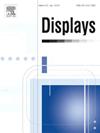Efficient p-i-n-p blue OLED devices by inserting organic heterojunctions for charge generation
IF 3.7
2区 工程技术
Q1 COMPUTER SCIENCE, HARDWARE & ARCHITECTURE
引用次数: 0
Abstract
An n-p type organic heterojunction composed of various materials was inserted between the Al electrode and the electron injection layer to fabricate an optimized p-i-n-p blue OLED device. The n-p type organic heterojunction generate carriers under reverse bias, reducing the injection barrier for carriers and regulating carrier balance. A p-n junction carrier device was fabricated to investigate their carrier transport properties. The energy levels of the p-layer and n-layer were analyzed using ultraviolet photo-electron spectroscopy (UPS) and low-energy inverse photoelectron spectroscopy (LEIPS). The p-i-n-p OLED with BPhen:15 %Ag2O (20 nm)/NPB:10 %MoO3 (10 nm) as the heterojunction shows a remarkable 0.6 V reduction in turn-on voltage. Current efficiency (CE), power efficiency (PE), and external quantum efficiency (EQE) increase by 29.3 %, 41.2 %, and 12.5 %, respectively, compared to the basic p-i-n OLED. Finally, FTIR spectra indicate a charge generation in the p-n junction, enabling a balanced carrier distribution.
求助全文
约1分钟内获得全文
求助全文
来源期刊

Displays
工程技术-工程:电子与电气
CiteScore
4.60
自引率
25.60%
发文量
138
审稿时长
92 days
期刊介绍:
Displays is the international journal covering the research and development of display technology, its effective presentation and perception of information, and applications and systems including display-human interface.
Technical papers on practical developments in Displays technology provide an effective channel to promote greater understanding and cross-fertilization across the diverse disciplines of the Displays community. Original research papers solving ergonomics issues at the display-human interface advance effective presentation of information. Tutorial papers covering fundamentals intended for display technologies and human factor engineers new to the field will also occasionally featured.
 求助内容:
求助内容: 应助结果提醒方式:
应助结果提醒方式:


